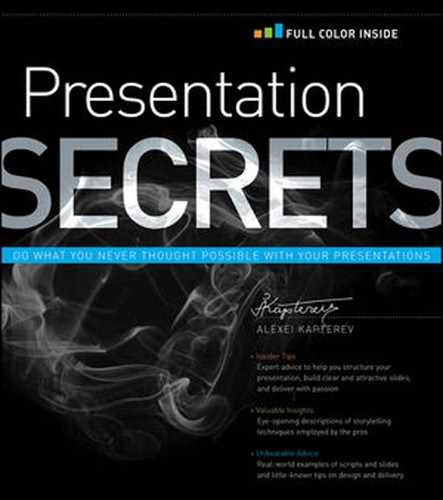TAKING FURTHER STEPS
Failing sucks. Perhaps this is the single most important motivation for improving in anything. After “Death by PowerPoint” became a hit, for a while it felt like I didn't need to know anything else about presentations. Also, it felt like the field itself was small and well researched. My honeymoon with presentations ended when I started to work with one of Russia's largest production companies and to deal with many real-life situations involving many different clients. Pretty soon I discovered that my knowledge and skills were inadequate. I had to learn more.
So I ordered some books from Amazon, visited some workshops, subscribed to even more blogs, and bought some software. Predictably, this made things much more complicated and therefore worse—although at that moment I didn't notice. What I did notice is that the field is in fact extremely rich in content, and the possibilities for learning are almost limitless. The same thing will happen to you. You need some time to assimilate the knowledge from this book, to try things, and to see what works for you and what doesn't. After a while, your progress will slow and you'll hit a plateau, where you will live comfortably until you suddenly realize that, at least as far as presentations are concerned, you still have a lot to learn. Then you get your motivation to dig deeper, to go on to the next resource, the next learning experience. It's a slow process going from resource to resource like this, really assimilating what each has to offer, but unless you proceed carefully you risk being overwhelmed by the amount of resources available to you.
Too many books end with a recommended reading list that contains dozens and sometimes even hundreds of books in alphabetical order. This approach doesn't strike me as particularly helpful (although it probably does work as a display of the author's erudition). You can't read all of those books, and you are unsure how to prioritize so you end up ditching the entire list. So I came up with an alternative “only the essentials” approach, doing some prioritization for you. In the sections that follow I cover only the most essential books, blogs, or areas of practice for presentations in general and for the three areas of presentations (story, slides, and delivery) I have covered in this book.
